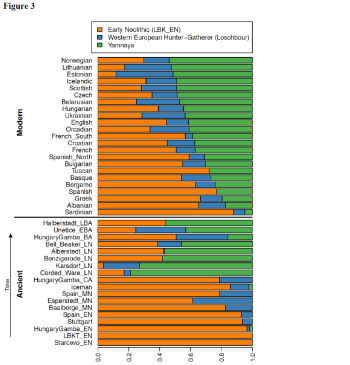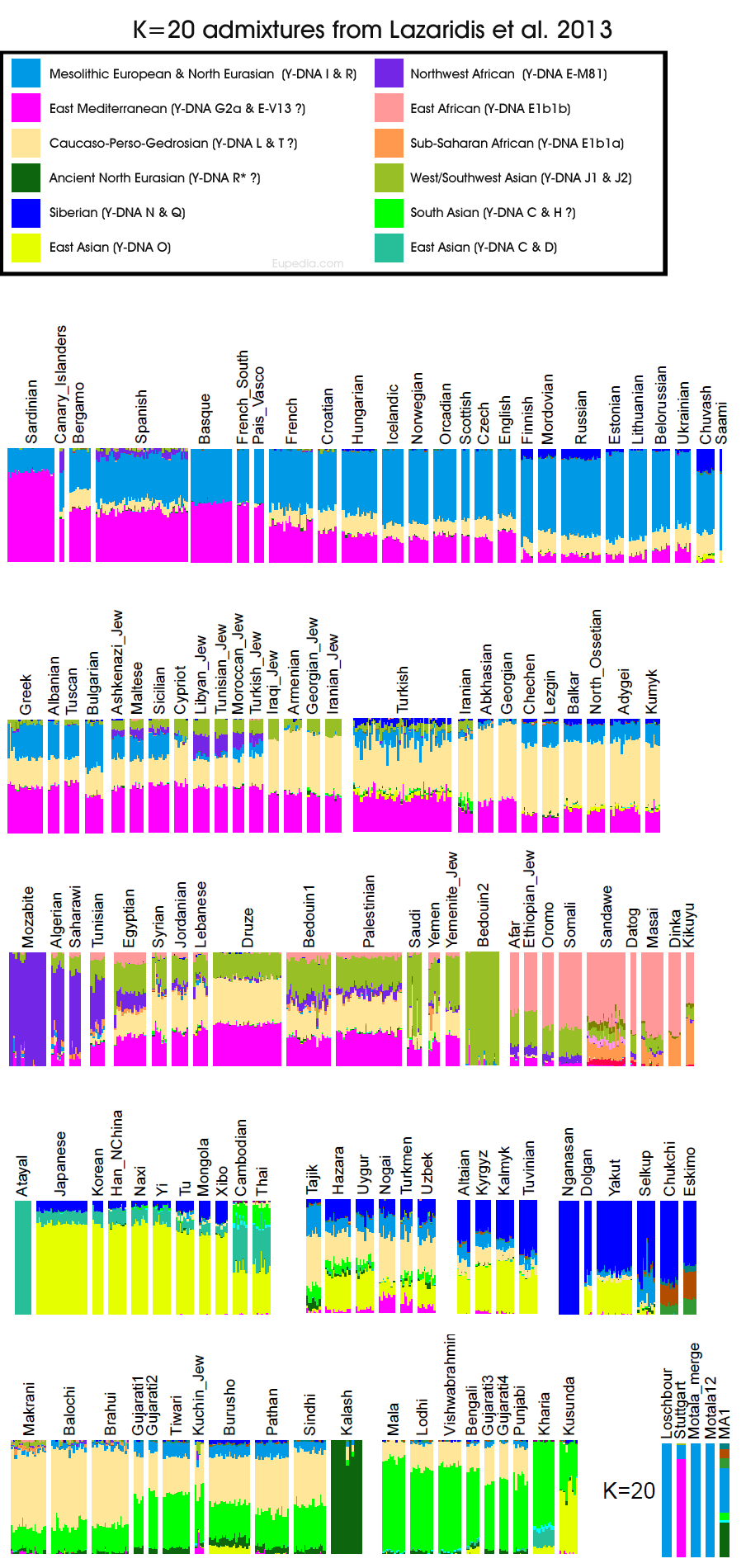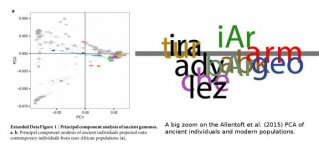It is not "********", it is stated by a great number of historians specializing in Rome that there was a significant amount of both slaves and free citizens that came from other areas of the empire. The funerary inscriptions of the majority of these people strongly suggest an Eastern origin.
No one is denying prehistoric Near Eastern in Italy either. However, we are talking about the admixture that Hellenthal et al. finds to be from historical times, which according to their calculations goes from late Roman to medieval times. People have been talking about military invaders, as usual, but for some reason they simply forget about other people who came to other lands by other means, in this case either as slaves or free citizens. Since Hellenthal et al.'s calculation includes late Roman times, there is no reason why we should deny outright this possible source. So if anything it is other people who have clear agendas, not me. I am simply offering a possible explanation based on Hellenthal et al.'s calculations. If their calculations had excluded Roman times then we would have to confine ourselves to trying to find any other possible explanations for it.
Hellenthal et al. also records Near Eastern admixture from what their calculations say are historical times in other parts of Italy, not just Tuscany.
You might want to research how slavery worked in the Roman empire. It wasn't like the slavery of the new world. It wasn't a life sentence based on race or ethnicity. You could escape it, even in your own lifetime, if you didn't die before your time on a galley or mine or on some latifundia where you were worked to death. So, for the lucky few who proved their worth to their masters because they had more intellect than the average, or some specialized skill, or were just plain lucky, you could escape it and perhaps intermarry with locals.
That would have been a steady drip of genes, coming from all parts of the empire, not just the Near East. Unless you'd like to go on record that northern and eastern slaves were more stupid and therefore less likely to be manumitted and to have a chance of surviving? Also, the slaves remaining in the last days of the empire actually contained a very high percentage of "locals", as worsening economic and climatic conditions drove more and more of the free peasantry into such poverty that for survival they sold themselves and their families into slavery. Then, when the end came, I assure you they would have been the least equipped for survival. Before pontificating on these matters, some actual unbiased research into the matter would be welcome. I assure you I don't misrepresent research, but I'm tired of doing all the work here. Look it up yourself.
Most importantly, I am tired of pointing out to you the logical fallacies in your argument.
Ralph and Coop's IBD analysis indicates no
substantial gene sharing after the Iron Age between Italy and any other country, with the exception of some parts of the Balkans. That is probably the Albanians moving into southern Italy. Until someone proves that is incorrect, your endless posts about slavery in Italy suddenly resulting in a 40%
new "Cypriot like" gene flow into Tuscans in the early Middle Ages are irrelevant. In addition, once again, even if there was an impact from slavery, those slaves would just as likely have been northern and eastern and western Europeans as Near Easterners.
Oh, and spare us the arguments over how many "Greek" names were assigned to slaves and what that might mean. Is that a serious basis for an analysis of Hellenthal et al? Have you ever heard of "fashion", for goodness sakes? Germanic and Gaulish and such names probably sounded too barbaric. You also obviously have no familiarity with naming conventions in the American south. We find Caesars, Scipios, Homers, a Paris, a Venus, Philbes and Polidores among the slave ship registers, among others. Were they the descendents of Roman and Greek slaves? The naming was the product of the classical education of their masters. How about the Jeremiah's and Abrahams? Did they enslave some Jews on the way from West Africa?
http://www.archives.gov/atlanta/finding-aids/slave-manifests/charleston/names.html
It also strains the bounds of credulity that slaves would have been deliberately distributed on a north to south cline which matches ancient migrations. What, was it like a resettlement station in Nazi Germany? All Germans and Gauls, you'll be resettled to northern Italy. All Greeks and Syrians, please turn right for transport to Campania and Sicily! Really? I also fail to see how it escapes you that if the
new gene flow was from a Cypriot like population, then the prior population of Italy was totally "French" and "British Isles" and "Germanic" like. Is that really where you want to go with this?
As to your comments about Hellenthal et al, I will give you the benefit of the doubt and suggest that you read Hellenthal
again, and
carefully. We have had a problem with you in the past where you misrepresent the findings of academic papers. There were consequences. Don't do it again.
So, as to the paper, there is no mention in the analysis of northern Italy of any mass admixture event involving a "Cypriot" like population in,
not the late empire, but at the
EARLIEST in 522 AD, and with an
average date of 900 AD.
Instead, the admixture date for northern Italy of a
"Welsh" like population, although it includes other northern European groups (
about 66%) with a "
Cypriot like" population (
about 33%) is estimated to have taken place in about
668 BC, (766 BC-550AD) That's actually a reasonably good fit for the
invasions by the Celts and the Germanic tribes. Do I really need to point out that
the new gene flow would have been from north to south? I do think the date may be too late, because the flow would have been going on since the time of the first Indo-European incursions, and the proportions seem very high for the "invader" component. Perhaps this is all complicated by the fact that none of these are the actual "ancient" groups, i.e. the "Welsh", and the "French" and the "Germans" also carried EEF admixture. Of course, maybe I'm partly affected by the fact that I don't want to think I am so heavily descended from the "invaders" who tried to or did bring down our civilization. That's possible. Unlike others, i do sometimes second guess myself by considering whether my "nativism" is affecting my intellectual judgements. I try very diligently not to let that happen.
In conclusion, none of your arguments are new, and none of them provide any support for a sudden infusion of
NEW "Cypriot like", or in other words EEF like genes into Tuscans in the period from the mid-500s to the 900's AD. There may indeed have been some new "Celtic" and a little "Germanic" like ancestry that perhaps made its way into Tuscany later than was the case for northern Italy, but I still maintain that the numbers are too high.
Drac II:According to some of the historians I have read, the eastern names among slaves and free foreigners are more common in the later times of the empire. Some proposed partial explanation for this increase in easterners are Caracalla's edict granting Roman citizenship to most free peoples of the empire, and the gradual expansion of Christianity, a religion that in its early stages spread via immigrants from the eastern parts of the empire:
https://books.google.com/books?id=6U...ianity&f=false
Page 310.
That excerpt has absolutely
nothing to do with your argument that Greek names in
slaves indicate that most of them came from the Near East. I told you what would happen if you misrepresented academic papers. DO IT ONE MORE TIME and I'll give you an infraction. I am really lax in handing them out, but that can be remedied. Am I sufficiently clear?




